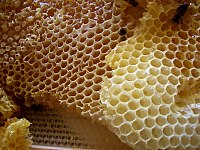User:Solistide/sandbox/Honey
Classification by packaging and processing[edit]
Generally, honey is bottled in its familiar liquid form. However, honey is sold in other forms, and can be subjected to a variety of processing methods.
A variety of honey flavors and container sizes and styles from the 2008 Texas State Fair
- Crystallized honey is honey in which some of the glucose content has spontaneously crystallized from solution as the monohydrate. Also called "granulated honey" or "candied honey." Honey that has crystallized (or commercially purchased crystallized) can be returned to a liquid state by warming.[1]
- Pasteurized honey is honey that has been heated in a pasteurization process which requires temperatures of 161 °F (72 °C) or higher. Pasteurization destroys yeast cells. It also liquefies any microcrystals in the honey, which delays the onset of visible crystallization. However, excessive heat exposure also results in product deterioration, as it increases the level of hydroxymethylfurfural (HMF)[citation needed] and reduces enzyme (e.g. diastase) activity. Heat also affects appearance (darkens the natural honey color), taste, and fragrance.[2]
- Raw honey is honey as it exists in the beehive or as obtained by extraction, settling or straining, without adding heat (although some honey that has been "minimally processed" is often labeled as raw honey).[3] Raw honey contains some pollen and may contain small particles of wax. Some allergy sufferers wrongly believe that raw, local honey can help build tolerance to the pollen in the air.[4]
- Strained honey has been passed through a mesh material to remove particulate material (pieces of wax, propolis, other defects) without removing pollen, minerals or enzymes.
- Filtered honey is honey of any type that has been filtered to the extent that all or most of the fine particles, pollen grains, air bubbles, or other materials normally found in suspension, have been removed.[5] The process typically heats honey to 150–170 °F (66–77 °C) to more easily pass through the filter.[6] Filtered honey is very clear and will not crystallize as quickly,[6] making it preferred by the supermarket trade.[7]
- Ultrasonicated honey has been processed by ultrasonication, a non-thermal processing alternative for honey. When honey is exposed to ultrasonication, most of the yeast cells are destroyed. Those cells that survive sonication generally lose their ability to grow, which reduces the rate of honey fermentation substantially. Ultrasonication also eliminates existing crystals and inhibits further crystallization in honey. Ultrasonically aided liquefaction can work at substantially lower temperatures of approximately 95 °F (35 °C) and can reduce liquefaction time to less than 30 seconds.[8]
- Creamed honey, also called whipped honey, spun honey, churned honey, honey fondant, and (in the UK) set honey, has been processed to control crystallization. Creamed honey contains a large number of small crystals, which prevent the formation of larger crystals that can occur in unprocessed honey. The processing also produces a honey with a smooth, spreadable consistency.[9]
- Dried honey has the moisture extracted from liquid honey to create completely solid, nonsticky granules. This process may or may not include the use of drying and anticaking agents.[10] Dried honey is used in baked goods,[10] and to garnish desserts. [citation needed]
- Comb honey is honey still in the honeybees' wax comb. It traditionally is collected by using standard wooden frames in honey supers. The frames are collected and the comb is cut out in chunks before packaging. As an alternative to this labor-intensive method, plastic rings or cartridges can be used that do not require manual cutting of the comb, and speed packaging. Comb honey harvested in the traditional manner is also referred to as "cut-comb honey".[1]: 13 [11]
- Chunk honey is packed in widemouth containers consisting of one or more pieces of comb honey immersed in extracted liquid honey.[1]: 13
- Honey decoctions are made from honey or honey by-products which have been dissolved in water, then reduced (usually by means of boiling). Other ingredients may then be added. (For example, abbamele has added citrus.) The resulting product may be similar to molasses.
- ^ a b c Flottum, Kim (2010). The Backyard Beekeeper: An Absolute Beginner's Guide to Keeping Bees in Your Yard and Garden. Quarry Books. pp. 170–. ISBN 978-1-61673-860-0.
- ^ Subramanian, R.; Hebbar, H. Umesh; Rastogi, N. K. (2007). "Processing of Honey: A Review". International Journal of Food Properties. 10: 127. doi:10.1080/10942910600981708.
- ^ Definition of Honey and Honey Products at the Wayback Machine (archived 3 December 2007). honey.com. Approved by the National Honey Board 15 June 1996; Updated 27 September 2003
- ^ Can Local Honey Help My Allergies?. Webmd.com (1 February 2012). Retrieved on 2 August 2013.
- ^ "United States Standards for Grades of Extracted Honey". USDA / Agricultural Marketing Service. Retrieved 20 January 2012.
- ^ a b Damerow, Gail (2011). The Backyard Homestead Guide to Raising Farm Animals: Choose the Best Breeds for Small-Space Farming, Produce Your Own Grass-Fed Meat, Gather Fresh Eggs, Collect Fresh Milk, Make Your Own Cheese, Keep Chickens, Turkeys, Ducks, Rabbits, Goats, Sheep, Pigs, Cattle, & Bees. Storey Publishing, LLC. pp. 167–. ISBN 978-1-60342-697-8.
- ^ First Regional Training Workshop for Beekeepers. Bib. Orton IICA / CATIE. 1992. pp. 55–.
- ^ Ultrasonic Honey Processing. Hielscher.com. Retrieved on 6 February 2011.
- ^ Sharma, Rajeev (2005). Improve your Health! with Honey. Diamond Pocket Books. pp. 33–. ISBN 978-81-288-0920-0.
- ^ a b Krell, Rainer (1996). Value-added Products Froom Beekeeping. Food & Agriculture Org. pp. 25–. ISBN 978-92-5-103819-2.
- ^ Honey Processing. Beeworks.com. Retrieved on 6 February 2011.


